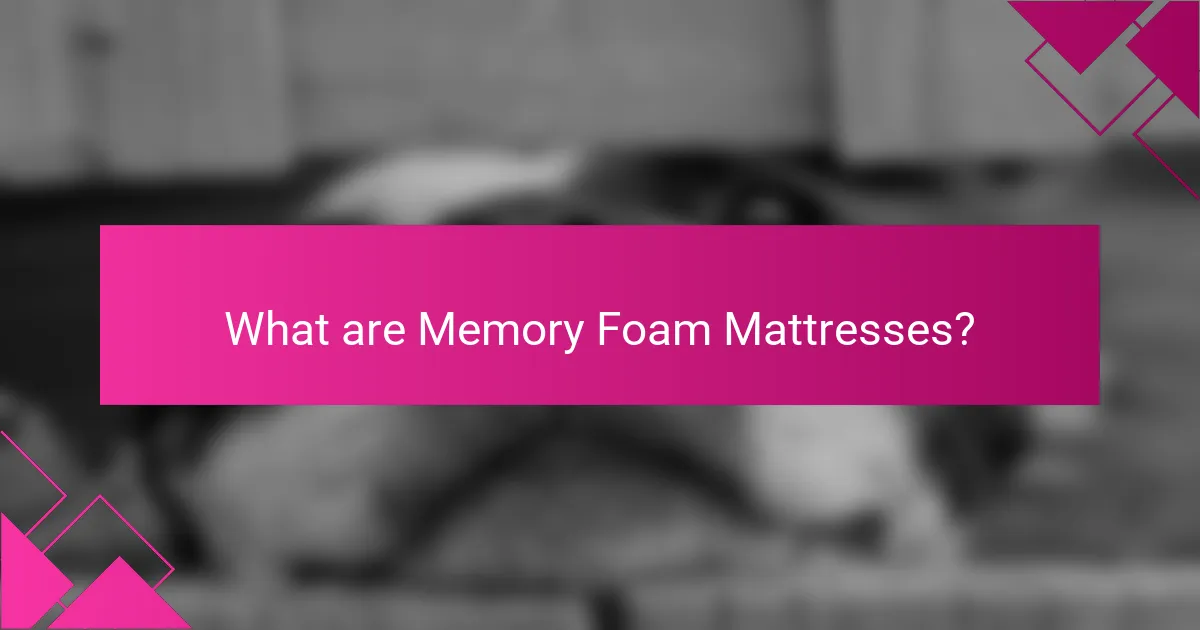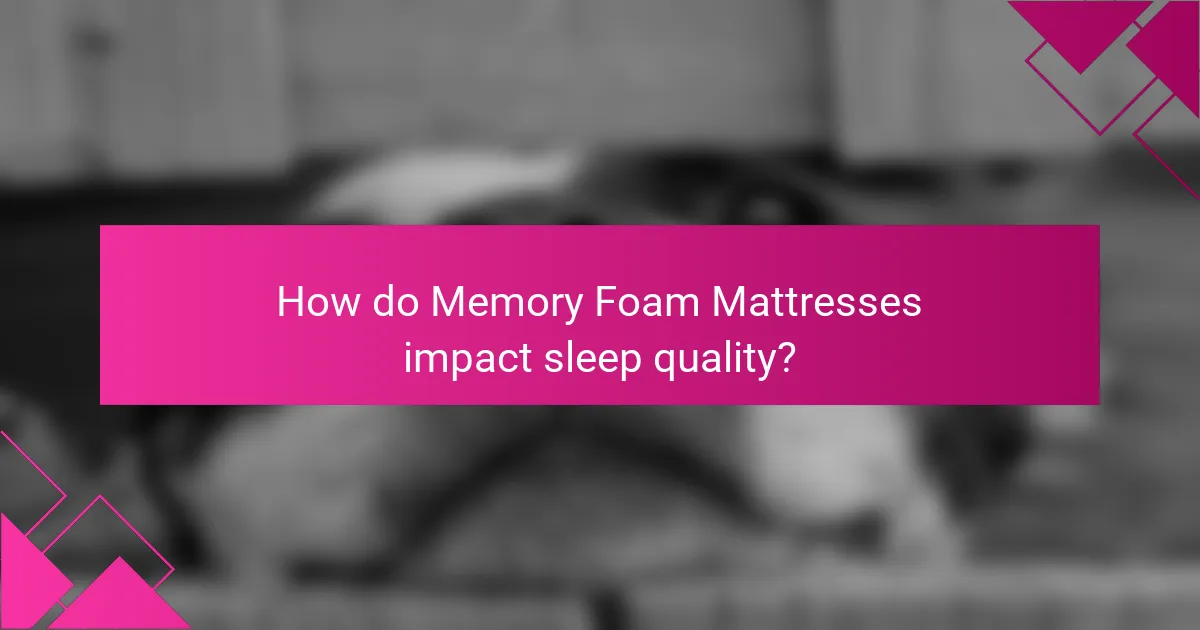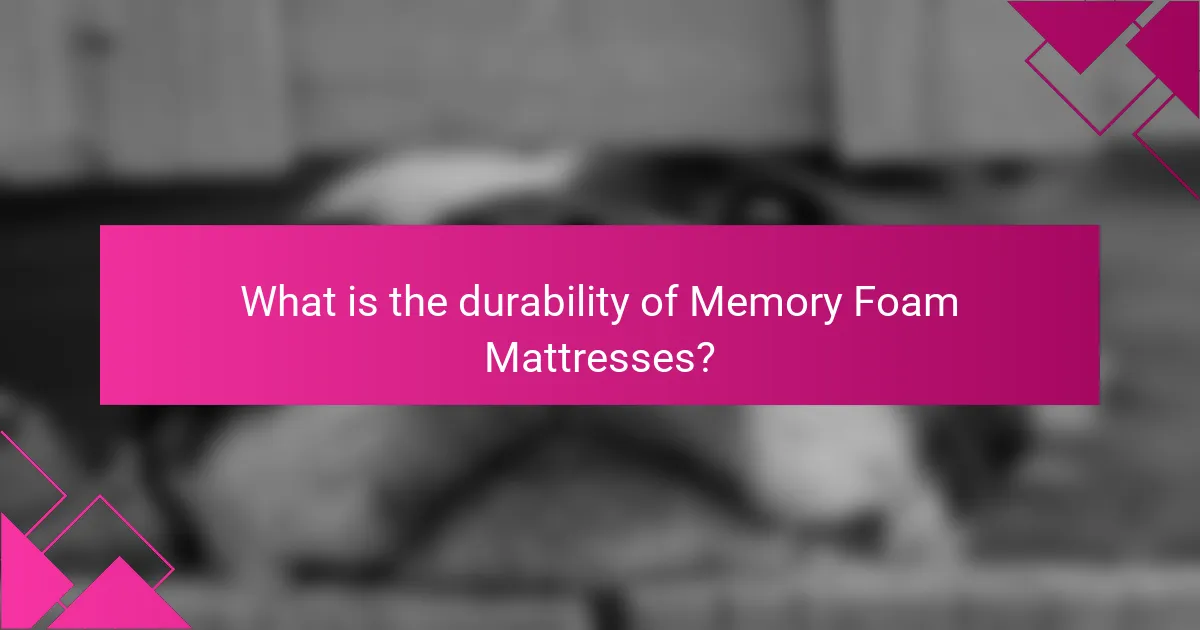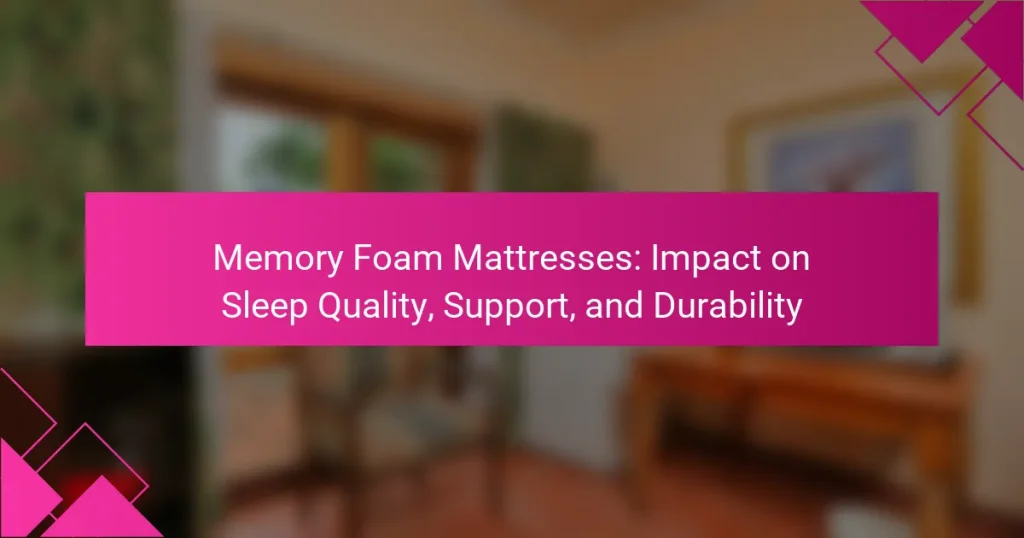Memory foam mattresses are made from viscoelastic foam, designed to conform to the body for optimal support and pressure relief. Originally developed by NASA, this material responds to heat and pressure, promoting even weight distribution and reducing discomfort during sleep. Research indicates that memory foam mattresses can enhance sleep quality, improve spinal alignment, and alleviate back pain. Additionally, they typically last between 7 to 10 years, with higher-density options offering greater durability. Proper maintenance can further extend their lifespan, making them a practical choice for consumers seeking better sleep solutions.

What are Memory Foam Mattresses?
Memory foam mattresses are bedding products made from viscoelastic foam. This material conforms to the body, providing support and pressure relief. Memory foam was originally developed by NASA in the 1960s for safety in aircraft seats. It responds to heat and pressure, allowing it to mold to the sleeper’s shape. This unique property helps distribute body weight evenly. As a result, memory foam mattresses can reduce discomfort during sleep. They are also known for minimizing motion transfer between partners. Studies show that these mattresses can improve sleep quality for many users.
How do Memory Foam Mattresses differ from traditional mattresses?
Memory foam mattresses differ from traditional mattresses in their material composition and support characteristics. Memory foam is made from viscoelastic foam that conforms to the body’s shape. This provides personalized support and pressure relief. In contrast, traditional mattresses often use innerspring coils or latex, which offer more bounce and less contouring. Memory foam absorbs movement, making it ideal for couples. Traditional mattresses may transfer motion more easily. Additionally, memory foam typically has a longer lifespan than traditional mattresses. Studies indicate that memory foam can reduce back pain and improve sleep quality due to its adaptive properties.
What materials are used in Memory Foam Mattresses?
Memory foam mattresses are primarily made from polyurethane foam. Polyurethane foam is a synthetic material that provides support and comfort. It is known for its viscoelastic properties, which allow it to conform to the body. Additionally, memory foam mattresses may include gel-infused layers for temperature regulation. Some models feature a layer of latex for added responsiveness. The cover materials often consist of polyester or cotton blends for breathability. These materials work together to enhance sleep quality and durability.
How does the manufacturing process affect the quality of Memory Foam Mattresses?
The manufacturing process directly influences the quality of memory foam mattresses. High-quality manufacturing ensures consistent density and durability. This process involves precise temperature control during foam creation. Additionally, the use of premium materials enhances comfort and support. Manufacturing defects can lead to uneven firmness and reduced lifespan. CertiPUR-US certification indicates safe, high-quality foam production. Studies show that well-manufactured memory foam improves sleep quality by providing better spinal alignment. Therefore, the manufacturing process is crucial for the overall performance of memory foam mattresses.
What are the key features of Memory Foam Mattresses?
Memory foam mattresses are designed to provide comfort and support through their unique material properties. They conform to the shape of the body, offering personalized support. This feature helps in distributing body weight evenly. Memory foam also absorbs motion, reducing disturbances when a partner moves. The material is typically temperature-sensitive, softening with heat to enhance comfort. Additionally, many memory foam mattresses are hypoallergenic, resisting dust mites and allergens. They often come with varying densities, affecting firmness and support levels. Finally, these mattresses are known for their durability, often lasting longer than traditional spring mattresses.
How does the density of memory foam impact comfort and support?
The density of memory foam significantly impacts comfort and support. Higher density memory foam typically offers better support. It conforms closely to the body, distributing weight evenly. This reduces pressure points and enhances comfort. Lower density foam may feel softer but often lacks durability. It may not provide adequate support over time. Studies show that medium to high-density foam improves sleep quality. A density of 4 to 5 pounds per cubic foot is often recommended for optimal comfort and support.
What types of memory foam are available in mattresses?
There are several types of memory foam available in mattresses. The primary types include traditional memory foam, gel-infused memory foam, and plant-based memory foam. Traditional memory foam is known for its excellent contouring and pressure relief. Gel-infused memory foam incorporates gel beads to enhance cooling properties. Plant-based memory foam is made from natural materials, reducing environmental impact. Each type offers unique benefits for sleep quality, support, and durability.

How do Memory Foam Mattresses impact sleep quality?
Memory foam mattresses significantly enhance sleep quality. They conform to the body’s shape, providing personalized support. This adaptability reduces pressure points, leading to less discomfort during the night. Studies show that users report improved sleep satisfaction and reduced tossing and turning. A study published in the Journal of Chiropractic Medicine found that memory foam mattresses can decrease back pain. Improved spinal alignment is another benefit, promoting healthier sleep postures. Overall, memory foam mattresses contribute to deeper, more restorative sleep.
What benefits do Memory Foam Mattresses provide for sleep?
Memory foam mattresses provide enhanced support and pressure relief for better sleep. They contour to the body’s shape, reducing pressure points. This helps alleviate discomfort during sleep. Memory foam also minimizes motion transfer. This feature is particularly beneficial for couples. Studies indicate that memory foam mattresses can improve sleep quality. Research published in the Journal of Chiropractic Medicine found that users reported less pain and improved sleep after using memory foam. Overall, these mattresses contribute to a more restful and restorative sleep experience.
How does pressure relief contribute to improved sleep quality?
Pressure relief enhances sleep quality by reducing discomfort during rest. Memory foam mattresses are designed to contour to the body’s shape. This contouring helps distribute body weight evenly. As a result, pressure points are alleviated, promoting better circulation. Improved circulation can lead to deeper, more restorative sleep. Studies indicate that individuals report less tossing and turning on pressure-relieving surfaces. This stability allows for longer periods of uninterrupted sleep. Overall, effective pressure relief directly correlates with enhanced sleep quality.
What role does motion isolation play in sleep comfort?
Motion isolation significantly enhances sleep comfort by reducing disturbances caused by movement. This characteristic allows individuals to sleep undisturbed even if their partner shifts positions. Memory foam mattresses excel in motion isolation due to their unique material properties. They absorb and dissipate energy from movements, preventing it from transferring across the surface. Studies indicate that mattresses with high motion isolation lead to improved sleep quality. A survey by the National Sleep Foundation found that 63% of couples reported better sleep when using mattresses with superior motion isolation. Consequently, effective motion isolation contributes to a more restful and uninterrupted sleep experience.
How do Memory Foam Mattresses accommodate different sleep positions?
Memory foam mattresses accommodate different sleep positions by conforming to the body’s shape. This adaptability provides support for various postures, including back, side, and stomach sleeping. For back sleepers, the foam supports the spine’s natural alignment. Side sleepers benefit from the cushioning around shoulders and hips, reducing pressure points. Stomach sleepers receive support that prevents excessive sinking, which can lead to spinal misalignment. The material’s viscoelastic properties allow it to respond to body heat and weight. This responsiveness ensures that the mattress contours to individual body shapes. Studies show that memory foam can improve overall sleep quality by reducing discomfort.
What are the best memory foam options for side sleepers?
The best memory foam options for side sleepers include models that provide optimal support and pressure relief. These mattresses typically feature a medium to medium-soft firmness level. This firmness helps to contour to the body’s curves, particularly around the shoulders and hips.
Brands like Tempur-Pedic offer high-quality memory foam that adapts well to side sleepers. The Tempur material is known for its durability and support. Another excellent option is the Nectar mattress, which provides a balanced feel and excellent motion isolation.
The Purple mattress, with its unique hyper-elastic polymer, also caters to side sleepers by offering pressure relief while maintaining support. Research indicates that proper spinal alignment is crucial for side sleepers to avoid discomfort.
A study published in the Journal of Chiropractic Medicine highlights the importance of mattress firmness in reducing pressure points for side sleepers. Therefore, selecting a memory foam mattress that balances softness and support is essential for a restful night’s sleep.
How do back and stomach sleepers benefit from memory foam support?
Back and stomach sleepers benefit from memory foam support by receiving proper spinal alignment and pressure relief. Memory foam contours to the body, providing support where needed. This helps maintain the natural curvature of the spine. For back sleepers, it prevents sinking too deeply, which can lead to discomfort. For stomach sleepers, it reduces the risk of neck strain by keeping the head aligned with the spine. Studies have shown that memory foam can reduce pressure points, promoting better blood circulation during sleep. This results in a more restful and uninterrupted sleep experience for both sleeping positions.

What is the durability of Memory Foam Mattresses?
Memory foam mattresses typically have a durability of 7 to 10 years. This durability is influenced by the quality of materials used in their construction. Higher-density memory foam tends to last longer than lower-density alternatives. Many manufacturers offer warranties ranging from 10 to 20 years, indicating confidence in their product’s lifespan. Regular maintenance, such as rotating the mattress, can also extend its durability. Research shows that proper care can significantly impact the longevity of memory foam mattresses.
How long do Memory Foam Mattresses typically last?
Memory foam mattresses typically last between 7 to 10 years. This lifespan can vary based on factors such as quality, usage, and maintenance. Higher-quality memory foam mattresses often use denser foam, which contributes to their durability. Regularly rotating the mattress can also help extend its lifespan. Additionally, many manufacturers provide warranties that reflect the expected durability, often ranging from 10 to 20 years. Studies indicate that proper care can significantly influence how long a memory foam mattress remains supportive and comfortable.
What factors influence the lifespan of a Memory Foam Mattress?
The lifespan of a memory foam mattress is influenced by several key factors. The quality of materials used in its construction significantly affects durability. High-density foam typically lasts longer than low-density foam. The frequency of use also plays a role; mattresses used daily wear out faster. Proper care and maintenance extend longevity. Regularly rotating the mattress helps prevent uneven wear. The weight of the sleepers impacts the foam’s compression and resilience. Environmental factors, such as humidity and temperature, can degrade foam over time. Lastly, the presence of protective covers can shield the mattress from spills and allergens, enhancing its lifespan.
How can proper care extend the durability of Memory Foam Mattresses?
Proper care can significantly extend the durability of memory foam mattresses. Regularly rotating the mattress helps distribute wear evenly. This practice can prevent sagging and prolong its lifespan. Using a mattress protector shields against spills and stains. This barrier maintains the foam’s integrity and hygiene. Keeping the mattress clean and vacuuming it regularly removes dust and allergens. This action prevents degradation of the foam material. Avoiding excessive weight on the mattress helps maintain its shape. Memory foam is designed to support body weight effectively, but overloading can cause damage. Following manufacturer guidelines for cleaning and maintenance is crucial. Adhering to these instructions can enhance the mattress’s longevity.
What warranties and guarantees are common for Memory Foam Mattresses?
Common warranties for memory foam mattresses typically range from 10 to 20 years. These warranties usually cover defects in materials and workmanship. Some brands also offer a 100-night trial period. This allows customers to test the mattress risk-free. If unsatisfied, they can return it for a full refund. Guarantees may also include a replacement policy for sagging beyond a certain depth, often 1 inch. Additionally, some manufacturers provide limited lifetime warranties. These warranties may cover specific issues like foam deterioration. It is essential to read the warranty terms carefully, as coverage can vary significantly between brands.
What should consumers look for in a mattress warranty?
Consumers should look for comprehensive coverage in a mattress warranty. Key elements include the duration of the warranty, which typically ranges from 10 to 25 years. A good warranty should cover defects in materials and workmanship. It should also include terms for sagging beyond a certain depth, commonly 1 inch or more. Additionally, consumers should check for any exclusions that may void the warranty. Many warranties require proper support from a foundation or frame. Understanding the claim process is crucial, including time frames and documentation needed. Consumers should also consider whether the warranty is prorated or non-prorated. Non-prorated warranties provide better long-term value.
How do trial periods affect the purchase decision for Memory Foam Mattresses?
Trial periods significantly influence the purchase decision for memory foam mattresses. They provide consumers with the opportunity to test the mattress in their own home. This experience allows buyers to assess comfort and support over time. Research indicates that 78% of consumers feel more confident purchasing a mattress with a trial period. Additionally, trial periods reduce the perceived risk associated with such a significant investment. Many brands offer trial periods ranging from 30 to 120 nights. This duration enables consumers to determine if the mattress meets their sleep needs. Positive experiences during the trial often lead to higher customer satisfaction and brand loyalty.
What tips can improve the experience with Memory Foam Mattresses?
To improve the experience with memory foam mattresses, consider adjusting the room temperature. Memory foam responds to heat, becoming softer in warmer environments. Keeping the room cool can enhance the mattress’s supportive qualities. Use a mattress protector to maintain hygiene and prolong lifespan. This helps prevent wear and tear from spills or sweat. Rotate the mattress regularly to promote even wear. This practice can extend its durability significantly. Choose the right foundation, such as a solid platform or adjustable base. Proper support enhances the mattress’s performance and comfort. Finally, allow the mattress to air out after unboxing. This reduces off-gassing odors, improving the overall sleeping environment.
How can mattress toppers enhance the comfort of Memory Foam Mattresses?
Mattress toppers can enhance the comfort of memory foam mattresses by providing additional cushioning and support. They can improve pressure relief, particularly for sensitive areas like shoulders and hips. Toppers can also adjust the firmness level, catering to personal preferences. Additionally, they can help regulate temperature, making sleep more comfortable. A study by the National Sleep Foundation indicates that proper support can lead to better sleep quality. This suggests that the right topper can significantly impact overall comfort and sleep satisfaction.
What maintenance practices are essential for Memory Foam Mattresses?
To maintain memory foam mattresses, regular care is essential. Rotate the mattress every three to six months to ensure even wear. Clean spills immediately with a mild detergent and water. Avoid using harsh chemicals that can damage the foam. Use a mattress protector to shield against allergens and moisture. Vacuum the mattress occasionally to remove dust and debris. Ensure proper ventilation to prevent moisture buildup. Follow the manufacturer’s instructions for specific care guidelines. These practices can extend the lifespan and performance of memory foam mattresses.
Memory foam mattresses are specialized bedding products made from viscoelastic foam that provides support and pressure relief by conforming to the body. This article explores the various attributes of memory foam mattresses, including their material composition, manufacturing processes, and key features that enhance sleep quality, such as pressure relief and motion isolation. Additionally, it examines how different sleep positions affect comfort and support, the durability of these mattresses, and the importance of warranties and trial periods for consumers. Overall, the content presents a comprehensive overview of how memory foam mattresses impact sleep quality, support, and longevity.


